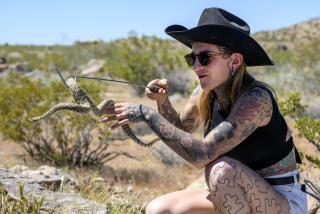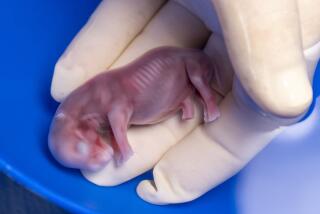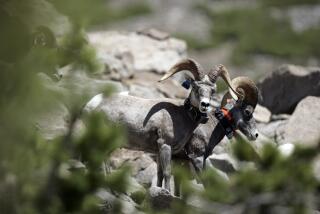Armed only with her grandmother’s shotgun, a South African woman fights to save her rhinos
Reporting from KLERKSDORP, South Africa — Lynne MacTavish lives in a small wooden house on her South African game reserve with a fierce pet emu, a juvenile ostrich, a flock of geese, two Jack Russell terriers and her grandma’s double-barreled shotgun to protect her rhinos.
She keeps an ugly statue at her gate: a tokoloshe, or evil spirit in the local traditional belief, installed by a witch doctor to ward off superstitious rhino poachers.
Every night MacTavish gets up after midnight, grabs her shotgun, clambers into her SUV and patrols for poachers.
She still gets flashbacks of the scene she found one windy October morning in 2014 and still cries telling the story. Poachers had killed two rhinos, including a pregnant cow she had known since the day it was born. Two more died as an indirect result of the attack and a calf, days from being born, was lost.
MacTavish, as tough as the spiky bush on her animal reserve in South Africa’s northwest, struggles to cover the cost of security guards. One local poacher has threatened to kill her.
South Africa is home to 80% of the world’s 25,000 rhinos. Hamstrung by corruption and security lapses, it loses three rhinos a day to poaching, 85% of them in state reserves. Private owners such as MacTavish have become important to the species’ survival, nurturing more than 6,500 rhinos on an estimated 330 private game reserves, spanning 5 million acres, that provide a relative degree of safety.
But security is costly — so much so that many reserves are closing their doors. To help generate revenue, private reserve operators have successfully sued to resume South Africa’s limited trade in rhino horns, which had been banned since 2009. The government is finalizing new regulations that will allow foreigners to export up to two horns apiece for personal use.
The measure has rocked the wildlife preservation world. Most wildlife advocates say opening the door even to “farmed” rhino horn sales could threaten an international effort to wipe out the trade across the globe. About 2,200 horns a year flow into the illegal trade, mostly poached, and opponents of the new trade rules argue that criminals will find ways to funnel poached horns into the new legal market.
“Reopening a domestic trade in rhino horn in South Africa would make it even harder for already overstretched law enforcement agents to tackle rhino crimes,” World Wildlife Fund policy manager Colman O’Criodain said in a statement.
“There is no domestic demand for rhino horn in South Africa, so it is inconceivable that anyone would buy it, unless they intend to sell it abroad illegally, or they are speculating that international trade will be legalized.”
South Africa’s Private Rhino Owners Assn. argues that a limited legal trade — using trimmed horn, without killing the animals — is the only safe way to meet demand in China and elsewhere in Asia. Selling horn, which regrows like fingernails, can help cover the huge cost of security and avert extinction, the owners contend.
The population is so finely balanced that if either side happens to be wrong, rhinos could die out within a decade.
When you are looking at an animal you’ve known its whole life and you see what they’ve done to it, it’s cruelty beyond words.
— Lynne MacTavish, South African private rhino owner who lost two rhinos to poachers
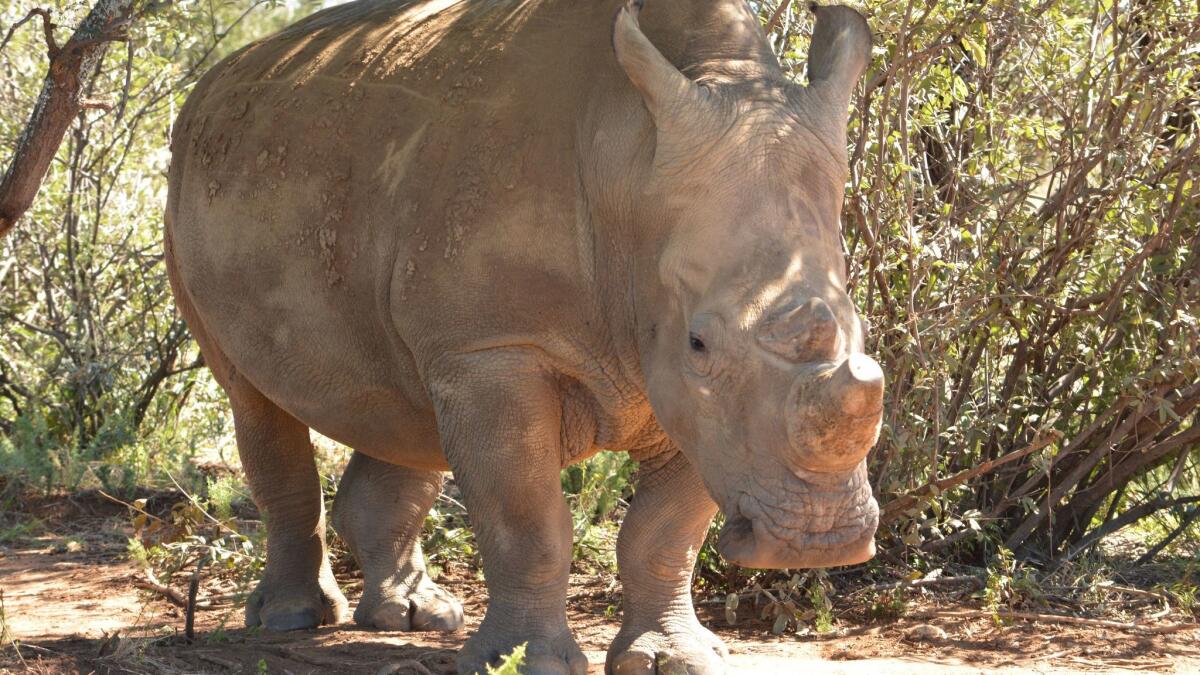
In the attack on MacTavish’s reserve in 2014, poachers crept in at night and shot a female rhino she had named Cheeky Cow. The animal ran for several miles, leading the poachers away from her calf, but the killers backed her and three other females up against a fence line and shot her again, also hitting another young pregnant female, Winnie.
They slashed Cheeky Cow’s spinal cord with a machete so she couldn’t move and while she was alive they smashed into her face with an ax to get her horns. Winnie was also alive when they hacked off her horns.
When she found Winnie’s body, MacTavish sat in the dirt and wept for half an hour.
“When you are looking at an animal you’ve known its whole life and you see what they’ve done to it, it’s cruelty beyond words,” MacTavish said. She knew then she had to dehorn her other rhinos “because you cannot bear the thought of any other rhino going through that horrific cruelty.”
She called the police to the scene, but they didn’t investigate the rhino carcasses, footprints or crime scene. They were drinking beer, she said, and the police captain asked her to light a barbecue fire so as not to waste “good meat.”
MacTavish eventually called in vets to de-horn all her rhinos; her 32-year-old bull, Patrol, died during the procedure.
She strongly supports the decision to lift the eight-year ban on legal rhino horn trading in South Africa.
“The ban has been disastrous,” she said, because “it meant the only way to get horn was to poach it. The price skyrocketed.” It created a huge temptation for employees of farms like hers to work with poachers, she added.
“By just giving information to a syndicate, they can earn more money than they would in a year. The money is so high and the risk is so low because of our courts and policing. It just spells extinction.”
::
At a much larger luxury private game reserve near Kruger National Park, the sign on the door of the security operations center reads: “War Room.”
Inside, black blinds cover one wall. Security chief Endrie Steyn, an ex-soldier with an air of reflexive suspicion, rolls up the blinds, revealing a board covered with spiderweb maps that include sightings of known poachers, suspects, contacts, photographs, addresses, meetings and car movements.
The reserve cut its annual poaching cases from 14 to two by installing high-tech equipment: thermal cameras capable of spotting poachers at night, CCTV cameras, sensors, fence alarms, a biometric system to check visitors’ fingerprints and a reliable communications network.
As two young rhino bulls munch contently by a creek on the reserve, hardened Angolan war veterans, with sunglasses and automatic weapons, cruise in jeeps.
The technology was the brainchild of lodge owner Bruce Watson, who requested that The Times not identify the reserve for security reasons.
Steyn has assembled a team of former police officers in the community as his eyes and ears, gathering intelligence by listening to conversations at taverns where would-be poachers gather.
“Three years ago, we were running from carcass to carcass,” adds reserve game warden David Powrie. “We lost a lot of rhinos. It was crisis management. Now we find out what’s happening outside, before it happens.”
Sixty percent of poaching incidents in South Africa occur in Kruger National Park, home to about 9,000 rhinos. Rangers, police, soldiers, state wildlife officers and former officials are frequently caught poaching.
With funding from the Dutch and British lotteries, the park has installed radar surveillance capable of detecting poachers at night. American billionaire Warren Buffett donated two helicopters.
But poaching syndicates are increasingly aggressive, with 2,882 known incursions into the park last year, a 30% increase from 2015. Yet fewer than 50 cases were prosecuted. Of those arrested, only 15% were convicted.
::
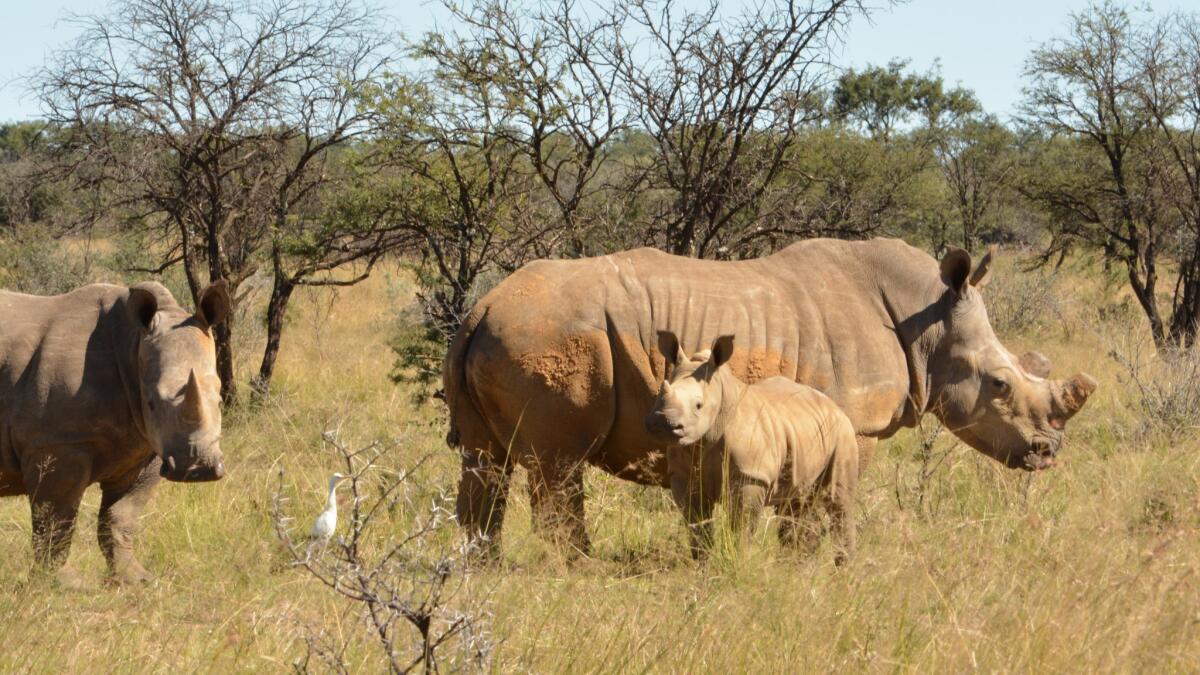
John Hume, the world’s biggest private rhino owner, sits in his SUV with two Jack Russell terriers on his lap, gazing at a rhino cow and her two calves. He owns about 1,500 white rhinos on a tranquil ranch on the wide flat plains of North West province. Poachers have killed 52 of his rhinos, but he has bred more than 1,000 calves in what he calls his private crusade to save rhinos from extinction. He says his ambition is to breed 200 a year, and last year he reached 180.
It began as a retirement hobby 25 years ago for the former vacation resort developer, but now it’s a $4.8-million-a-year operation, with more than half of that devoted to security.
Hume was one of two private reserve owners who filed the lawsuit that successfully overturned the ban on private horn trading in South Africa. He has detractors among wildlife organizations, who see him as an opportunist who now stands to get rich selling horn. But Hume’s supporters say his breeding operation has done as much as anyone else to save rhinos from extinction.
The horns of the rhinos on Hume’s preserve are trimmed every two years to deter poachers.
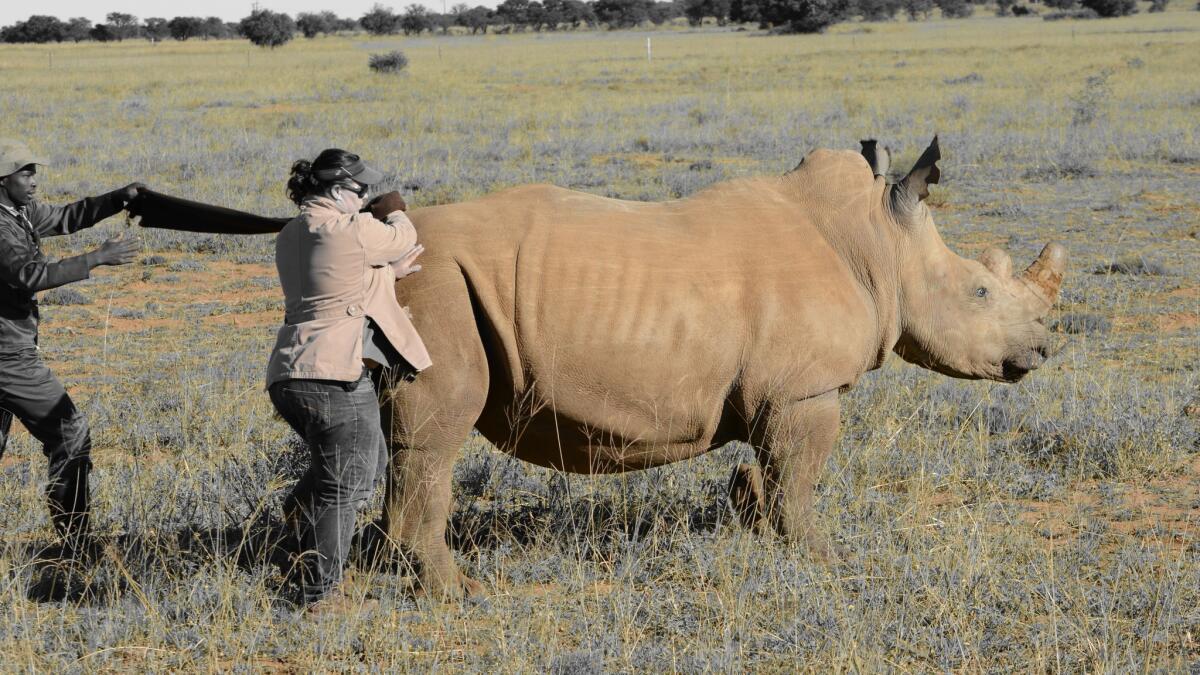
Hume’s ranch has a military-style security center nicknamed Afghanistan and a chopper that flies nightly. Only two rhinos have been poached in the last 18 months; neither of them had been de-horned because they were due to be sold to a safari park. Hume suspects that two of his employees, who knew the location of the two rhinos and the security routine, led the poachers to the two animals. (They failed lie detector tests about the attack and fled.)
“The Achilles’ heel in my project is people…. That’s what we need: Less people and more high-tech solutions,” Hume said. He said he hopes that selling his horn will allow him to buy a $3-million radar system to detect nighttime incursions.
Organizations such as the World Wildlife Fund fear that South Africa’s domestic rhino horn trade will be a backdoor to international trade because the process of issuing government permits is corrupt. That, along with lax policing in Asia, could result in a flood of horns on the commercial market.
Hume plans to auction off rhino horn in South Africa in August and predicts Chinese residents in South Africa will be the main buyers. Although black market prices for poached horn in Asia are reported to be $14,000 to $30,000 a pound, Hume expects to get a fraction of that: $2,700 to $4,500 a pound.
“I don’t believe we will ever be able to have no security, therefore I believe it’s essential to the survival of this project that we sell the horn,” he said. “Without selling the rhino horn, no breeding project will succeed.”
Small private owners such as MacTavish cannot afford drones, helicopters, radars or sensors. According to the rhino owners association, at least 70 rhino owners gave up and sold their rhinos between 2009 and 2015. As a result, 500,000 acres of rhino range has been lost.
MacTavish clings on, dedicating every spare cent to supporting her rhinos. She brought her children up in a converted ostrich shed before building her spartan little house. She helps make a living by hosting university study groups.
By a dam on her property, she has erected a shrine to the rhinos she lost to poachers. At one side lies Cheeky Cow’s skull, with its horrific injury. Despite her security detail, she lives in dread of another poaching incident.
“You basically put your life on the line for these animals.”
But in April, it seemed worthwhile. A new calf was born in the middle of spectacular lightning and thunder. She called him Storm.
Twitter: @RobynDixon_LAT
ALSO
Another victim of Venezuela’s unrest: Caracas’ once-renowned zoo
A million miles away behind her own front door: A Saudi woman’s secret apartment
More to Read
Sign up for Essential California
The most important California stories and recommendations in your inbox every morning.
You may occasionally receive promotional content from the Los Angeles Times.
